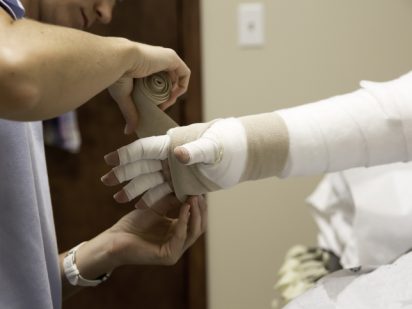Lymphedema is the blockage of the lymphatic vessels in the arms or legs, leading to fluid retention. It is estimated that up to 10 million Americans, as well as hundreds of millions of people worldwide, suffer from lymphedema.
The lymphatic system is a network of organs, lymph nodes, ducts, and vessels that produces a fluid (lymph) that flows through the body and returns to the bloodstream as part of the body’s immune system. If the system is impaired due to cancer treatment, trauma, surgery, or genetic disposition, the lymph fluid builds up in the tissues, resulting in chronic swelling, usually in an arm or leg. The highest incidence of lymphedema in the United States is observed following breast cancer surgery.
Lymphedema can be primary, which means it occurs on its own, or it can be secondary, which means it is caused by another disease or condition; the latter form is more common. Causes of secondary lymphedema can include:
• Surgery. Removal of or injury to lymph nodes and lymph vessels may result in lymphedema. For example, lymph nodes may be removed to check for the spread of breast cancer, and lymph nodes may be injured in surgery that involves blood vessels in the limbs.
• Radiation treatment for cancer. Radiation can cause scarring and inflammation of the lymph nodes or lymph vessels.
• Cancer. If cancer cells block lymphatic vessels, lymphedema may result. For instance, a tumor growing near a lymph node or lymph vessel could enlarge enough to block the flow of the lymph fluid.
• Infection. An infection of the lymph nodes or parasites can restrict the flow of lymph fluid. (Infection-related lymphedema is most common in tropical and subtropical regions and is more likely to occur in developing countries.)
“It is progressive and will not disappear by itself. Typically, lymphedema affects one extremity only; or if both extremities are involved, it’s usually asymmetrical,” said Aimee Clemens, PT, DPT, CLT, a certified lymphedema therapist. “Once the condition has progressed, it definitely can interfere with daily function and mobility.”
Signs of lymphedema, according to the National Cancer Institute, include swelling in an arm, leg, fingers, or toes; a heavy feeling in a limb, a tight feeling in the skin, joint stiffness, or tightness when wearing clothing, shoes, or jewelry. Diagnosis may be confirmed through a physical exam and tests, including an MRI.
Once a diagnosis is established, lymphedema therapy is the most comprehensive form of treatment. While lymphedema cannot be cured, treatment can help. The most effective treatment for lymphedema is complete decongestive therapy, or CDT, the gold standard for lymphedema care, which is performed by a certified lymphedema therapist.
Complete decongestive therapy has four components:
• Manual Lymphatic Drainage – a manual technique to increase the activity of the lymphatic system and move the interstitial fluid.
• Compression therapy – prevents the accumulation of fluid with the use of short stretch bandages. Once the extremity is decongested, compression garments are fitted to the patient and worn during the day.
• Exercises – customized program for each patient while the patient is wearing compression bandages or garment.
• Skin care – addresses dryness and other skin issues that can increase risk for infection.
Since 2014, lymphedema therapy has been included as a service through Trinity Health’s Outpatient Physical Therapy department. The department includes four certified lymphedema therapists: Aimee Clemens, PT, DPT, CLT; Amber Pankratz, PT, CLT; Nicole Kutch, OTR/L, CHT, CLT; and Kara Thomas, COTA, CLT. A referral is needed.
Trinity Health Outpatient Physical and Occupational Therapy is located at Health Center – West, Suite 102, 101 3rd Ave SW, Minot.

